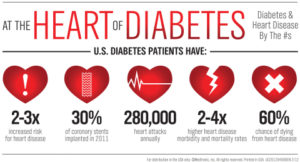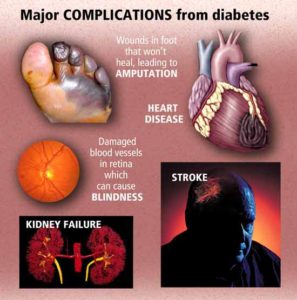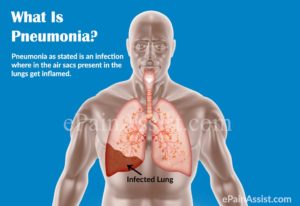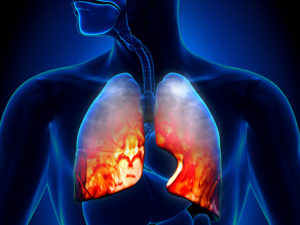7: Diabetes (diabetes mellitus)
- Deaths: 73,831
- Males: 38,324
- Females: 35,507
- Rate: 23.7
- Age-adjusted rate: 21.6
- Percentage of total deaths: 2.93%.
Diabetes is a disease in which blood glucose levels are above normal. Most of the food we eat is turned into glucose, or sugar, for our bodies to use for energy. The pancreas, an organ that lies near the stomach, makes a hormone called insulin to help glucose get into the cells of our bodies. When a person has diabetes, the body either does not make enough insulin or cannot use insulin as well as it should. This causes sugar to build up in the blood.
Diabetes can cause serious health complications including heart disease, blindness, kidney failure, and lower-extremity amputations.
Type 1 diabetes, which was previously called insulin-dependent diabetes mellitus (IDDM) or juvenile-onset diabetes, may account for about 5% of all diagnosed cases of diabetes.
Type 2 diabetes, which was previously called non-insulin-dependent diabetes mellitus (NIDDM) or adult-onset diabetes, may account for about 90-95% of all diagnosed cases of diabetes.
The estimated costs of diabetes in the US in 2012 was $245 billion. Direct medical costs accounted for $176 billion of that total and indirect costs such as disability, work loss and premature death accounted for $69 billion.
Warning signs and symptoms of diabetes
People who think they might have diabetes must visit a physician for diagnosis. They may have some or none of the following symptoms:
- Frequent urination
- Excessive thirst
- Unexplained weight loss
- Extreme hunger
- Sudden vision changes
- Tingling or numbness in hands or feet
- Feeling very tired much of the time
- Very dry skin
- Sores that are slow to heal
- More infections than usual.
Nausea, vomiting, or stomach pains may accompany some of these symptoms in the abrupt onset of insulin-dependent diabetes, now called type 1 diabetes.
Can diabetes be prevented?
Researchers are making progress in identifying the exact genetics and “triggers” that predispose some individuals to develop type 1 diabetes, but prevention remains elusive.
A number of studies have shown that regular physical activity can significantly reduce the risk of developing type 2 diabetes. Type 2 diabetes is associated with obesity.
There is no known way to prevent type 1 diabetes. Several clinical trials for preventing type 1 diabetes are currently in progress with additional studies being planned.
The Diabetes Prevention Program (DPP), a large prevention study of people at high risk for diabetes, showed that lifestyle intervention that resulted in weight loss and increased physical activity in this population can prevent or delay type 2 diabetes and in some cases return blood glucose levels to within the normal range. Other international studies have shown similar results.
Recent developments on diabetes from MNT news
Diabetes rates in the US ‘leveling off’
A new study from the CDC finds that between 2008 and 2012, diabetes prevalence and incidence rates plateaued, possibly because of slowing obesity rates.
Could a single injection stop diabetes?
Researchers who gave mice with type 2 diabetes the growth factor FGF1, found it reversed diabetes and kept blood glucose within a safe range for 2 days with just one injection.
8: Influenza and pneumonia
- Deaths: 53,826
- Males: 25,401
- Females: 28,425
- Rate: 17.3
- Age-adjusted rate: 15.7
- Percentage of total deaths: 2.13%.
Influenza accounts for 1,532 deaths annually and pneumonia 52,294.
Influenza (flu) is a highly contagious viral infection that is one of the most severe illnesses of the winter season. The reason influenza is more prevalent in the winter is not known; however, data suggest the virus survives and is transmitted better in cold temperatures. Influenza is spread easily from person to person, usually when an infected person coughs or sneezes.
Influenza and pneumonia are the eighth leading cause of death in the US with around 53,826 deaths each year.
A person can have the flu more than once because the virus that causes the disease may belong to different strains of one of three different influenza virus families: A, B or C. Type A viruses tend to have a greater effect on adults, while type B viruses are a greater problem in children.
Influenza can be complicated by pneumonia, which is a serious infection or inflammation of the lungs. The air sacs fill with pus and other liquid, blocking oxygen from reaching the bloodstream. If there is too little oxygen in the blood, the body’s cells cannot work properly, which can lead to death.
Pneumonia can have over 30 different causes, including various chemicals, bacteria, viruses, mycoplasmas and other infectious agents such as pneumocystis (fungi).
Together, pneumonia and influenza cost the US economy more than $40.2 billion in 2005. This figure includes more than $6 billion due to indirect costs (such as time lost from work) and $34.2 billion due to direct costs (such as medical expenses).
Warning signs and symptoms of influenza and pneumonia
Signs and symptoms of influenza include:
- Fever
- Headache
- Cough
- Chills
- Sore throat
- Nasal congestion
- Muscle aches
- Loss of appetite
- Malaise.
Signs and symptoms of pneumonia include:
- Fever
- Wheezing
- Cough
- Chills
- Rapid breathing
- Chest pains
- Loss of appetite
- Malaise
- Feeling of weakness or ill health.
Can influenza and pneumonia be prevented?
We basically know what pneumonia is right? If not, on problem it is this: Pneumonia is an infection that inflames the air sacs in one or both lungs. The air sacs may fill with fluid or pus (purulent material), causing cough with phlegm or pus or mucus (color-yellow to green), fatigue, sweating, fever, chills, nausea or vomiting and difficulty breathing. A variety of organisms, including bacteria, viruses and fungi, can cause pneumonia. Treatment is antibiotics.
Most important, methods of prevention with influenza and pneumonia include:
- Flu shot every year to prevent seasonal influenza
- Vaccination against pneumococcal pneumonia if you are at high risk of getting this type of pneumonia
- Wash hands frequently, especially after blowing nose, going to the bathroom, diapering, and before eating or preparing foods
- Do not smoke. Tobacco damages the lungs’ ability to fight off infection, and smokers have been found to be at a higher risk of getting pneumonia.
- Since pneumonia often follows respiratory infections, be aware of any symptoms that linger for more than a few days
- Good health habits – a healthy diet, rest, regular exercise, etc. – help prevent viruses and respiratory illnesses
- Hib vaccine prevents pneumonia in children from Haemophilus influenzae type B
- A drug called Synagis (palivizumab) can be given to some children younger than 24 months to prevent pneumonia caused by respiratory syncytial virus
- With cancer or HIV patients, a doctor should be consulted about additional ways to prevent pneumonia and other infections.
Recent developments on influenza and pneumonia from MNT news
Goji berries protect against the flu in new study
A study in older mice suggests that, when coupled with the flu vaccine, goji berries offer extra protection against the flu by boosting the immune system and diminishing symptoms.
New vaccine protects against staph-induced pneumonia
A vaccine that targeted surface proteins increased disease severity, whereas one that targeted toxins secreted by the bacteria protected against staph-induced pneumonia.



